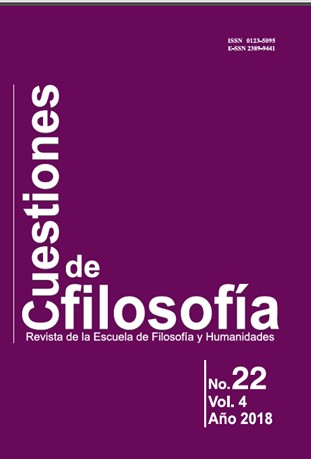Performance, performatividad y memoria

Abstract
El objetivo del presente artículo de reflexión es hacer evidente la relación entre la categoría de performatividad en Judith Butler y el arte de la performance como una aproximación a la construcción de la memoria. Por un lado, el arte de la performance ofrece un problema en torno al registro, al archivo y a la memoria de la acción artística al considerar que el acto es irrepetible, único y fugaz. Esta discusión está vinculada con la reperformación como alternativa de memoria que conserva la naturaleza de esta prácticaartística. Por otro lado, de acuerdo con Butler, la identidad es un efecto de una serie de performances regulados, esto revela cómo la performatividad sugiere un tipo de identidad no esencial donde la memoria está siempre abierta a nuevas inscripciones cuyo soporte está en la reiteración de actos discontinuos. En consecuencia, la repetición de los actos que propone Butler permite comprender que en la reperformance existe otra forma para abordar una memoria restaurada.Keywords
performatividad, performance, memoria, identidad, repetición
References
- Abramovic, V.; Avgikos, J.; Iles, C.; McEvilley, T.; Obrist, H. U.; Pejic, B.& Wulffen, T. (1998). Marina Abramovic: Artist Body. Perfomances 1969-1998. Milano: Edizioni Charta.
- Banks, G. (2014). The Tensile: Repetition, Reperformance, Rearticulation. Popular Culture Association of Australia and New Zealand (PopCAANZ). Peer Reviewed Proceedings of 5th Annual Popular Culture Association of Australia and New Zealand (pp. 184-195). Hobart: PopCAANZ.
- Barthold, L. S. (2014). True Identities: From Performativity to Festival. Hypatia 29 (4), 808-823.
- Beisenbach, K. (2010). Marina Abramovic. The Artist is Present. New York: Museum of Modern Art.
- Brant, H. J. (2013). “El enemigo es múltiple y adopta disfraces”: La performatividad y la identidad queer en El placer desbocado de Ernesto Schoo. Hispania, 96 (4), 657-671.
- Abramovic, V.; Avgikos, J.; Iles, C.; McEvilley, T.; Obrist, H. U.; Pejic, B. & Wulffen, T. (1998). Marina Abramovic: Artist Body. Perfomances 1969-1998. Milano: Edizioni Charta.
- Banks, G. (2014). The Tensile: Repetition, Reperformance, Rearticulation. Popular Culture Association of Australia and New Zealand (PopCAANZ). Peer Reviewed Proceedings of 5th Annual Popular Culture Association of Australia and New Zealand. 184-195. Hobart: PopCAANZ.
- Barthold, L. S. (2014). True Identities: From Performativity to Festival. Hypatia 29 (4), 808-823. DOI: https://doi.org/10.1111/hypa.12106
- Beisenbach, K. (2010). Marina Abramovic. The Artist is Present. New York: Museum of Modern Art.
- Brant, H. J. (2013). “El enemigo es múltiple y adopta disfraces”: La performatividad y la identidad queer en El placer desbocado de Ernesto Schoo. Hispania, 96 (4), 657-671. DOI: https://doi.org/10.1353/hpn.2013.0114
- Rae, G. (2014). Traces of Identity In Deleuze’s Differential Ontology. International Journal of Philosophical Studies, 22 (1), 86-105. DOI: https://doi.org/10.1080/09672559.2013.861003
- Rayner, A. (2006). Ghosts: Death’s Double and the Phenomena of Theatre. Minneapolis: University of Minnesota Press.
- Reason, M. (2003). Archive or Memory? The Detritus of Live Performance. New Theatre Quarterly, 19 (1), 82-89. DOI: https://doi.org/10.1017/S0266464X02000076
- Roa, J. (2015). Deleuze, el pliegue, el ritornelo y la relación arte territorio. Cuestiones de Filosofía, 17, 258-254. DOI: https://doi.org/10.19053/01235095.4300
- Schechner, R. (2011). Restauración de la conducta. D. Taylor & M. Fuentes (Eds.), Estudios avanzados de performance. 33-49. México: Fondo de Cultura Económica.
- Schechner, R. (2013). Performance Studies: An Introduction. New York: Routledge. DOI: https://doi.org/10.4324/9780203715345
- Scheneider, R. (2011). In the meantime: performance remains. Performing Remains. Art and war in times of theatrical reenactment. London: Routledge and Taylor & Francis Group.
- Taylor, J. A. (2015). Reflecting subjects. passion, sympathy, and society in Hume’s philosophy. Oxford: Oxford University Press. DOI: https://doi.org/10.1093/acprof:oso/9780198729525.001.0001
- Tomic, M. (2008). Rituals and Repettitions:The Displacement of Context in Marina Abramovics Seven Easy Pieces. (Master of Arts), The University of British Columbia Vacouver.
- Triana, D. (2018). Expressivity and Performativity: The Body in its Sexual Being. Eidos, 29 (29), 201-224. http://rcientificas.uninorte.edu.co/index.php/eidos/article/view/9521 DOI: https://doi.org/10.14482/eidos.29.9521
- Vásquez, M. (2016). Fundamentos para una verdad artística: una lectura en clave filosófica de los orígenes de la producción audiovisual. Cuestiones de Filosofía, 2(19), 15-30. DOI: https://doi.org/10.19053/01235095.v2.n19.2016.5678